Strategic Analysis of Business Models Using Standard Management Tools
VerifiedAdded on 2020/04/07
|13
|3159
|29
AI Summary
The task requires a thorough examination of strategic management models such as the Boston Consulting Group (BCG) matrix, GE/McKinsey matrix, and SWOT analysis. Students will evaluate how these tools contribute to decision-making processes in organizations by assessing their strengths, weaknesses, opportunities, and threats, market growth prospects, and competitive positioning. Additionally, students are expected to explore real-world applications of these models, discussing case studies or examples that illustrate their effectiveness. The goal is to develop a nuanced understanding of strategic management practices and their implications for business performance.
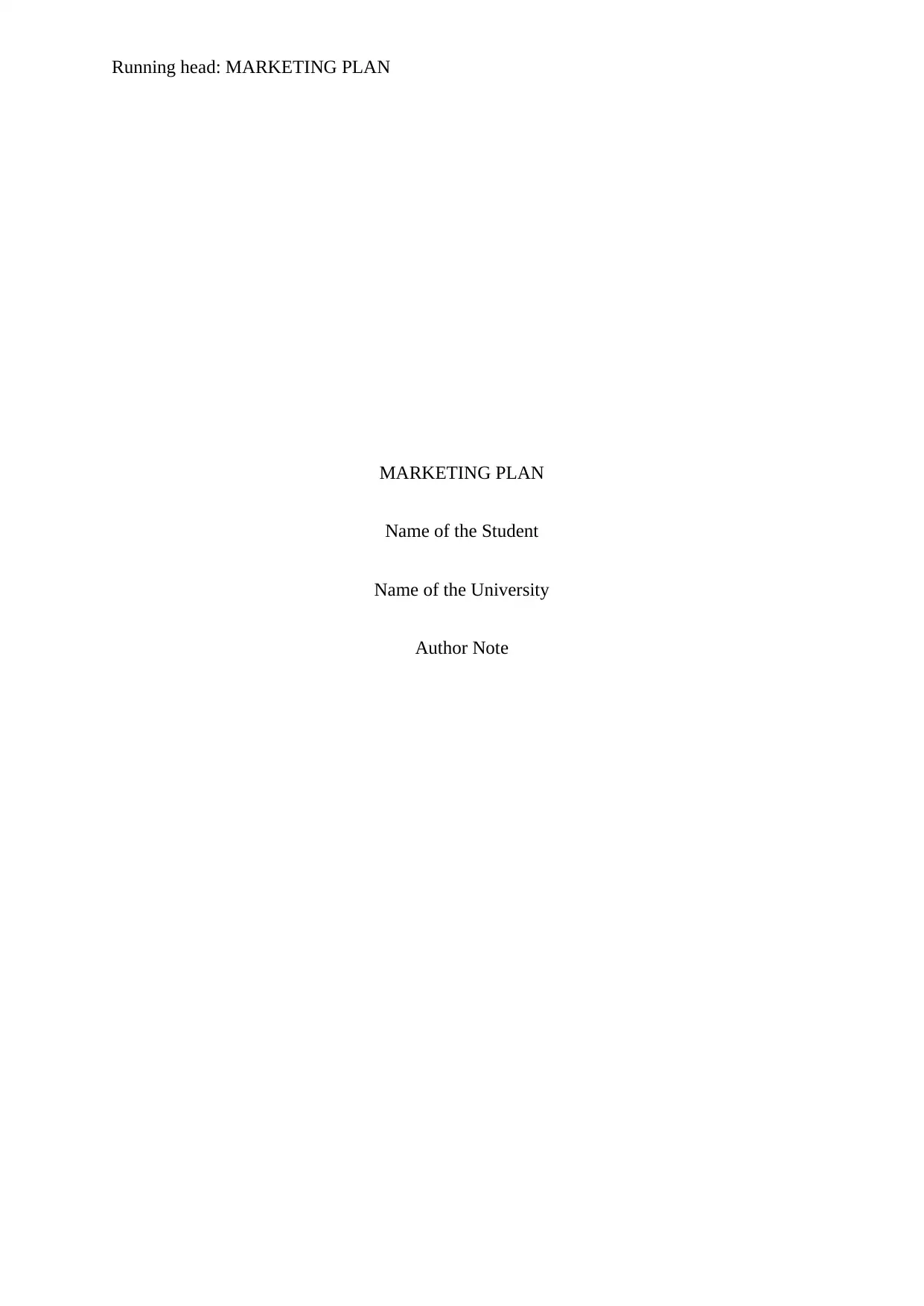
Running head: MARKETING PLAN
MARKETING PLAN
Name of the Student
Name of the University
Author Note
MARKETING PLAN
Name of the Student
Name of the University
Author Note
Paraphrase This Document
Need a fresh take? Get an instant paraphrase of this document with our AI Paraphraser
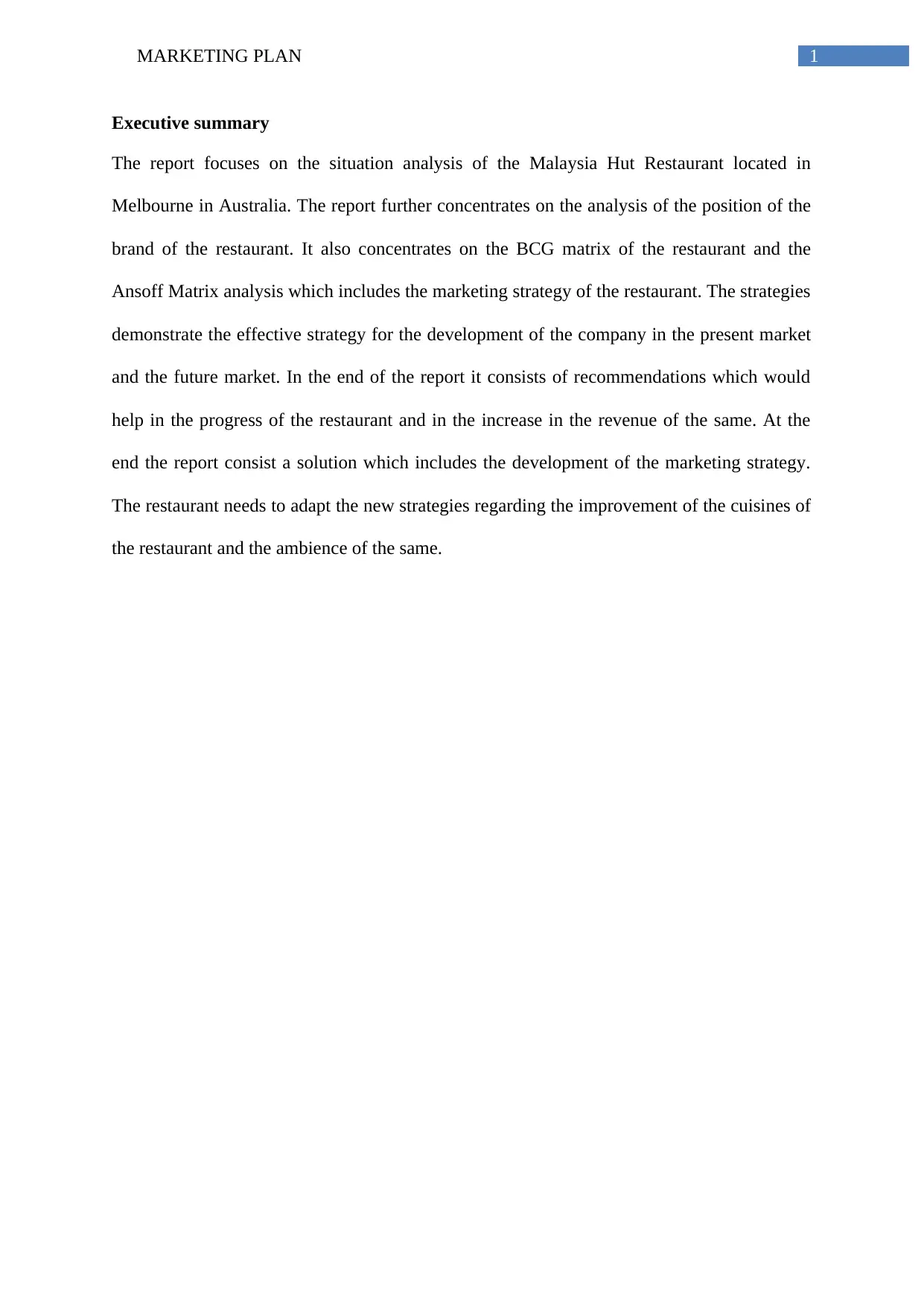
1MARKETING PLAN
Executive summary
The report focuses on the situation analysis of the Malaysia Hut Restaurant located in
Melbourne in Australia. The report further concentrates on the analysis of the position of the
brand of the restaurant. It also concentrates on the BCG matrix of the restaurant and the
Ansoff Matrix analysis which includes the marketing strategy of the restaurant. The strategies
demonstrate the effective strategy for the development of the company in the present market
and the future market. In the end of the report it consists of recommendations which would
help in the progress of the restaurant and in the increase in the revenue of the same. At the
end the report consist a solution which includes the development of the marketing strategy.
The restaurant needs to adapt the new strategies regarding the improvement of the cuisines of
the restaurant and the ambience of the same.
Executive summary
The report focuses on the situation analysis of the Malaysia Hut Restaurant located in
Melbourne in Australia. The report further concentrates on the analysis of the position of the
brand of the restaurant. It also concentrates on the BCG matrix of the restaurant and the
Ansoff Matrix analysis which includes the marketing strategy of the restaurant. The strategies
demonstrate the effective strategy for the development of the company in the present market
and the future market. In the end of the report it consists of recommendations which would
help in the progress of the restaurant and in the increase in the revenue of the same. At the
end the report consist a solution which includes the development of the marketing strategy.
The restaurant needs to adapt the new strategies regarding the improvement of the cuisines of
the restaurant and the ambience of the same.

2MARKETING PLAN
Table of Contents
Introduction................................................................................................................................3
Situation analysis.......................................................................................................................3
Stages of product lifecycle.........................................................................................................4
Brand positioning map...............................................................................................................6
BCG matrix................................................................................................................................7
Ansoff Matrix analysis...............................................................................................................9
Conclusion..................................................................................................................................9
References................................................................................................................................11
Table of Contents
Introduction................................................................................................................................3
Situation analysis.......................................................................................................................3
Stages of product lifecycle.........................................................................................................4
Brand positioning map...............................................................................................................6
BCG matrix................................................................................................................................7
Ansoff Matrix analysis...............................................................................................................9
Conclusion..................................................................................................................................9
References................................................................................................................................11
⊘ This is a preview!⊘
Do you want full access?
Subscribe today to unlock all pages.

Trusted by 1+ million students worldwide
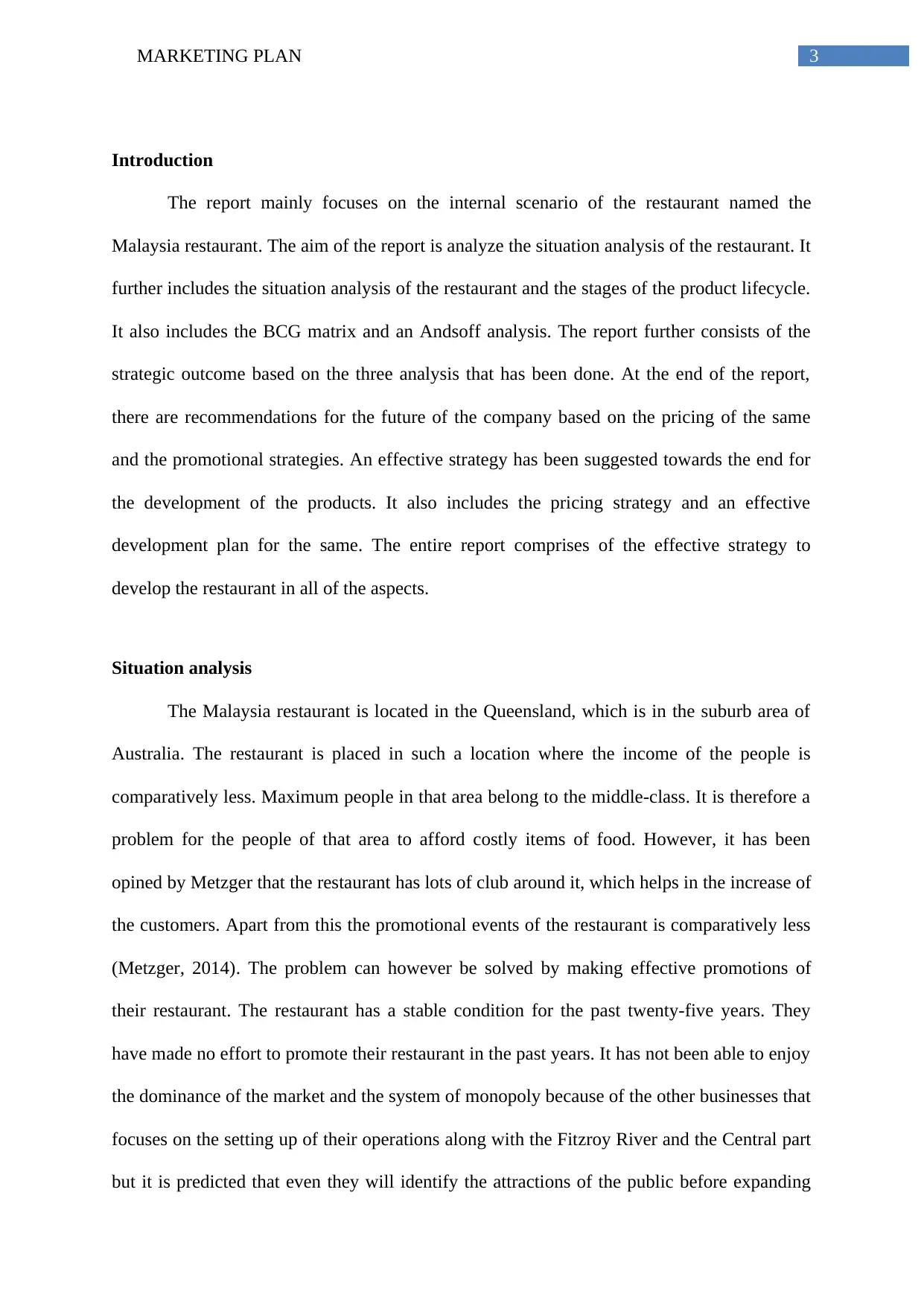
3MARKETING PLAN
Introduction
The report mainly focuses on the internal scenario of the restaurant named the
Malaysia restaurant. The aim of the report is analyze the situation analysis of the restaurant. It
further includes the situation analysis of the restaurant and the stages of the product lifecycle.
It also includes the BCG matrix and an Andsoff analysis. The report further consists of the
strategic outcome based on the three analysis that has been done. At the end of the report,
there are recommendations for the future of the company based on the pricing of the same
and the promotional strategies. An effective strategy has been suggested towards the end for
the development of the products. It also includes the pricing strategy and an effective
development plan for the same. The entire report comprises of the effective strategy to
develop the restaurant in all of the aspects.
Situation analysis
The Malaysia restaurant is located in the Queensland, which is in the suburb area of
Australia. The restaurant is placed in such a location where the income of the people is
comparatively less. Maximum people in that area belong to the middle-class. It is therefore a
problem for the people of that area to afford costly items of food. However, it has been
opined by Metzger that the restaurant has lots of club around it, which helps in the increase of
the customers. Apart from this the promotional events of the restaurant is comparatively less
(Metzger, 2014). The problem can however be solved by making effective promotions of
their restaurant. The restaurant has a stable condition for the past twenty-five years. They
have made no effort to promote their restaurant in the past years. It has not been able to enjoy
the dominance of the market and the system of monopoly because of the other businesses that
focuses on the setting up of their operations along with the Fitzroy River and the Central part
but it is predicted that even they will identify the attractions of the public before expanding
Introduction
The report mainly focuses on the internal scenario of the restaurant named the
Malaysia restaurant. The aim of the report is analyze the situation analysis of the restaurant. It
further includes the situation analysis of the restaurant and the stages of the product lifecycle.
It also includes the BCG matrix and an Andsoff analysis. The report further consists of the
strategic outcome based on the three analysis that has been done. At the end of the report,
there are recommendations for the future of the company based on the pricing of the same
and the promotional strategies. An effective strategy has been suggested towards the end for
the development of the products. It also includes the pricing strategy and an effective
development plan for the same. The entire report comprises of the effective strategy to
develop the restaurant in all of the aspects.
Situation analysis
The Malaysia restaurant is located in the Queensland, which is in the suburb area of
Australia. The restaurant is placed in such a location where the income of the people is
comparatively less. Maximum people in that area belong to the middle-class. It is therefore a
problem for the people of that area to afford costly items of food. However, it has been
opined by Metzger that the restaurant has lots of club around it, which helps in the increase of
the customers. Apart from this the promotional events of the restaurant is comparatively less
(Metzger, 2014). The problem can however be solved by making effective promotions of
their restaurant. The restaurant has a stable condition for the past twenty-five years. They
have made no effort to promote their restaurant in the past years. It has not been able to enjoy
the dominance of the market and the system of monopoly because of the other businesses that
focuses on the setting up of their operations along with the Fitzroy River and the Central part
but it is predicted that even they will identify the attractions of the public before expanding
Paraphrase This Document
Need a fresh take? Get an instant paraphrase of this document with our AI Paraphraser
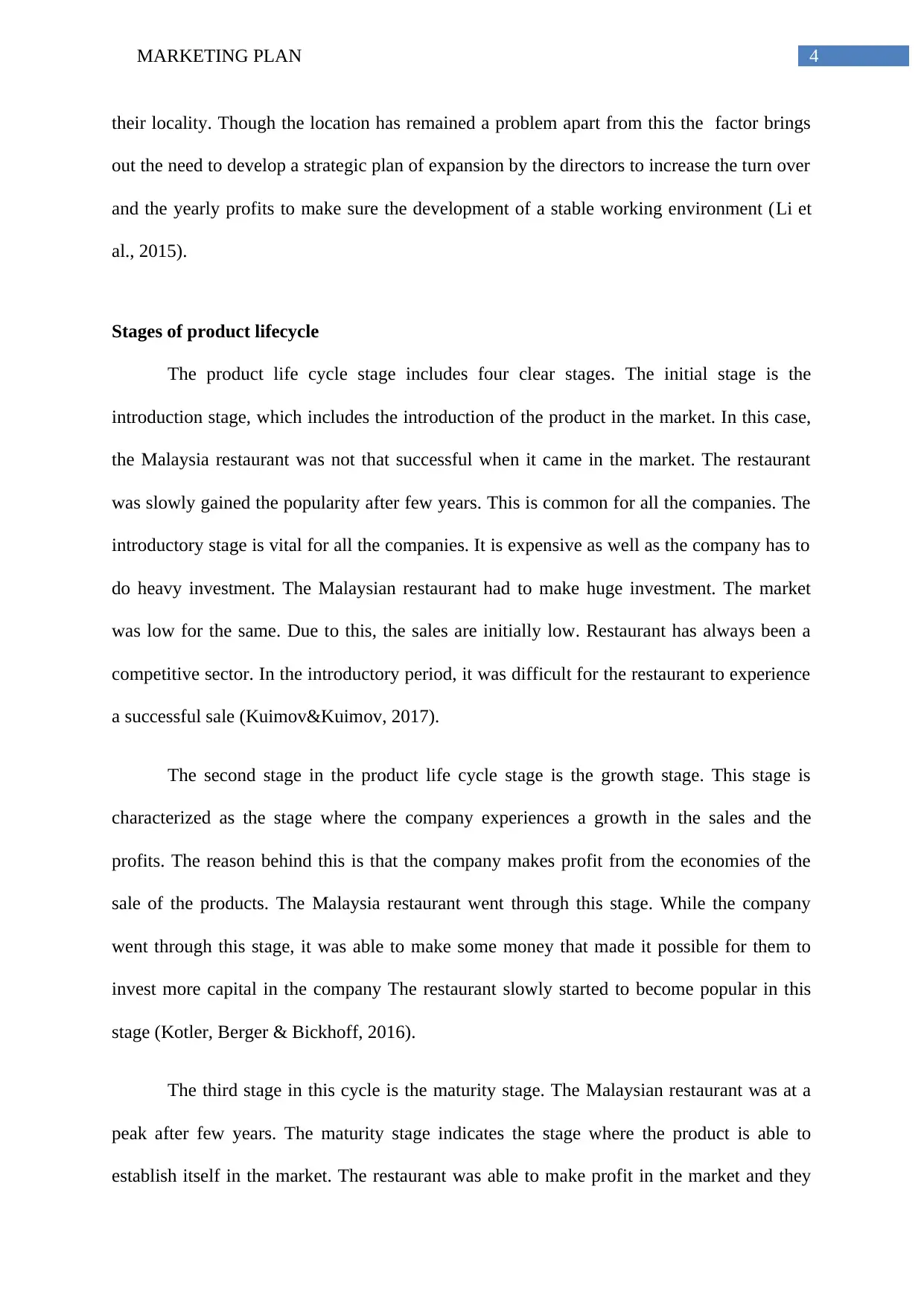
4MARKETING PLAN
their locality. Though the location has remained a problem apart from this the factor brings
out the need to develop a strategic plan of expansion by the directors to increase the turn over
and the yearly profits to make sure the development of a stable working environment (Li et
al., 2015).
Stages of product lifecycle
The product life cycle stage includes four clear stages. The initial stage is the
introduction stage, which includes the introduction of the product in the market. In this case,
the Malaysia restaurant was not that successful when it came in the market. The restaurant
was slowly gained the popularity after few years. This is common for all the companies. The
introductory stage is vital for all the companies. It is expensive as well as the company has to
do heavy investment. The Malaysian restaurant had to make huge investment. The market
was low for the same. Due to this, the sales are initially low. Restaurant has always been a
competitive sector. In the introductory period, it was difficult for the restaurant to experience
a successful sale (Kuimov&Kuimov, 2017).
The second stage in the product life cycle stage is the growth stage. This stage is
characterized as the stage where the company experiences a growth in the sales and the
profits. The reason behind this is that the company makes profit from the economies of the
sale of the products. The Malaysia restaurant went through this stage. While the company
went through this stage, it was able to make some money that made it possible for them to
invest more capital in the company The restaurant slowly started to become popular in this
stage (Kotler, Berger & Bickhoff, 2016).
The third stage in this cycle is the maturity stage. The Malaysian restaurant was at a
peak after few years. The maturity stage indicates the stage where the product is able to
establish itself in the market. The restaurant was able to make profit in the market and they
their locality. Though the location has remained a problem apart from this the factor brings
out the need to develop a strategic plan of expansion by the directors to increase the turn over
and the yearly profits to make sure the development of a stable working environment (Li et
al., 2015).
Stages of product lifecycle
The product life cycle stage includes four clear stages. The initial stage is the
introduction stage, which includes the introduction of the product in the market. In this case,
the Malaysia restaurant was not that successful when it came in the market. The restaurant
was slowly gained the popularity after few years. This is common for all the companies. The
introductory stage is vital for all the companies. It is expensive as well as the company has to
do heavy investment. The Malaysian restaurant had to make huge investment. The market
was low for the same. Due to this, the sales are initially low. Restaurant has always been a
competitive sector. In the introductory period, it was difficult for the restaurant to experience
a successful sale (Kuimov&Kuimov, 2017).
The second stage in the product life cycle stage is the growth stage. This stage is
characterized as the stage where the company experiences a growth in the sales and the
profits. The reason behind this is that the company makes profit from the economies of the
sale of the products. The Malaysia restaurant went through this stage. While the company
went through this stage, it was able to make some money that made it possible for them to
invest more capital in the company The restaurant slowly started to become popular in this
stage (Kotler, Berger & Bickhoff, 2016).
The third stage in this cycle is the maturity stage. The Malaysian restaurant was at a
peak after few years. The maturity stage indicates the stage where the product is able to
establish itself in the market. The restaurant was able to make profit in the market and they
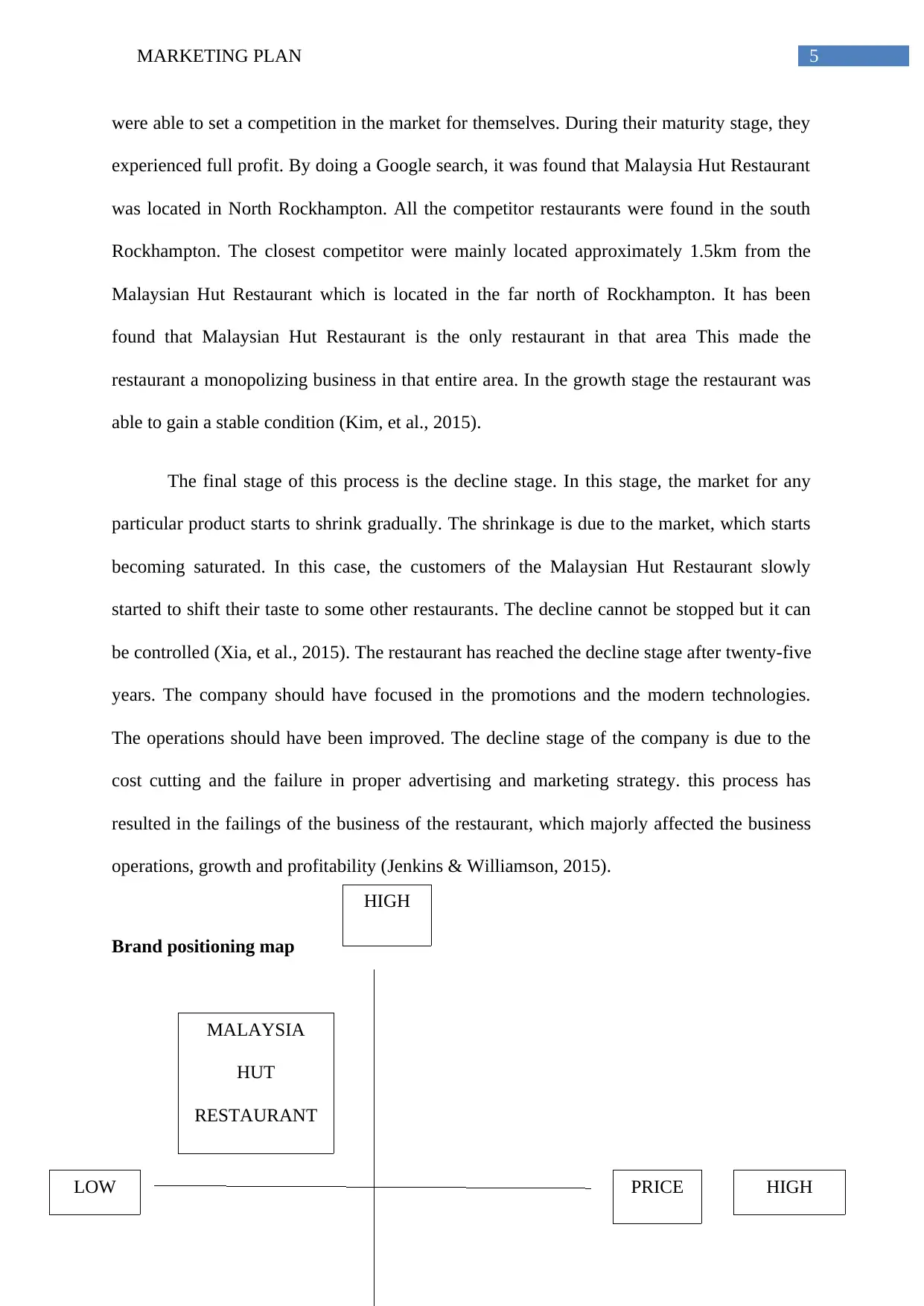
5MARKETING PLAN
were able to set a competition in the market for themselves. During their maturity stage, they
experienced full profit. By doing a Google search, it was found that Malaysia Hut Restaurant
was located in North Rockhampton. All the competitor restaurants were found in the south
Rockhampton. The closest competitor were mainly located approximately 1.5km from the
Malaysian Hut Restaurant which is located in the far north of Rockhampton. It has been
found that Malaysian Hut Restaurant is the only restaurant in that area This made the
restaurant a monopolizing business in that entire area. In the growth stage the restaurant was
able to gain a stable condition (Kim, et al., 2015).
The final stage of this process is the decline stage. In this stage, the market for any
particular product starts to shrink gradually. The shrinkage is due to the market, which starts
becoming saturated. In this case, the customers of the Malaysian Hut Restaurant slowly
started to shift their taste to some other restaurants. The decline cannot be stopped but it can
be controlled (Xia, et al., 2015). The restaurant has reached the decline stage after twenty-five
years. The company should have focused in the promotions and the modern technologies.
The operations should have been improved. The decline stage of the company is due to the
cost cutting and the failure in proper advertising and marketing strategy. this process has
resulted in the failings of the business of the restaurant, which majorly affected the business
operations, growth and profitability (Jenkins & Williamson, 2015).
Brand positioning map
HIGH
LOW PRICE
MALAYSIA
HUT
RESTAURANT
HIGH
were able to set a competition in the market for themselves. During their maturity stage, they
experienced full profit. By doing a Google search, it was found that Malaysia Hut Restaurant
was located in North Rockhampton. All the competitor restaurants were found in the south
Rockhampton. The closest competitor were mainly located approximately 1.5km from the
Malaysian Hut Restaurant which is located in the far north of Rockhampton. It has been
found that Malaysian Hut Restaurant is the only restaurant in that area This made the
restaurant a monopolizing business in that entire area. In the growth stage the restaurant was
able to gain a stable condition (Kim, et al., 2015).
The final stage of this process is the decline stage. In this stage, the market for any
particular product starts to shrink gradually. The shrinkage is due to the market, which starts
becoming saturated. In this case, the customers of the Malaysian Hut Restaurant slowly
started to shift their taste to some other restaurants. The decline cannot be stopped but it can
be controlled (Xia, et al., 2015). The restaurant has reached the decline stage after twenty-five
years. The company should have focused in the promotions and the modern technologies.
The operations should have been improved. The decline stage of the company is due to the
cost cutting and the failure in proper advertising and marketing strategy. this process has
resulted in the failings of the business of the restaurant, which majorly affected the business
operations, growth and profitability (Jenkins & Williamson, 2015).
Brand positioning map
HIGH
LOW PRICE
MALAYSIA
HUT
RESTAURANT
HIGH
⊘ This is a preview!⊘
Do you want full access?
Subscribe today to unlock all pages.

Trusted by 1+ million students worldwide
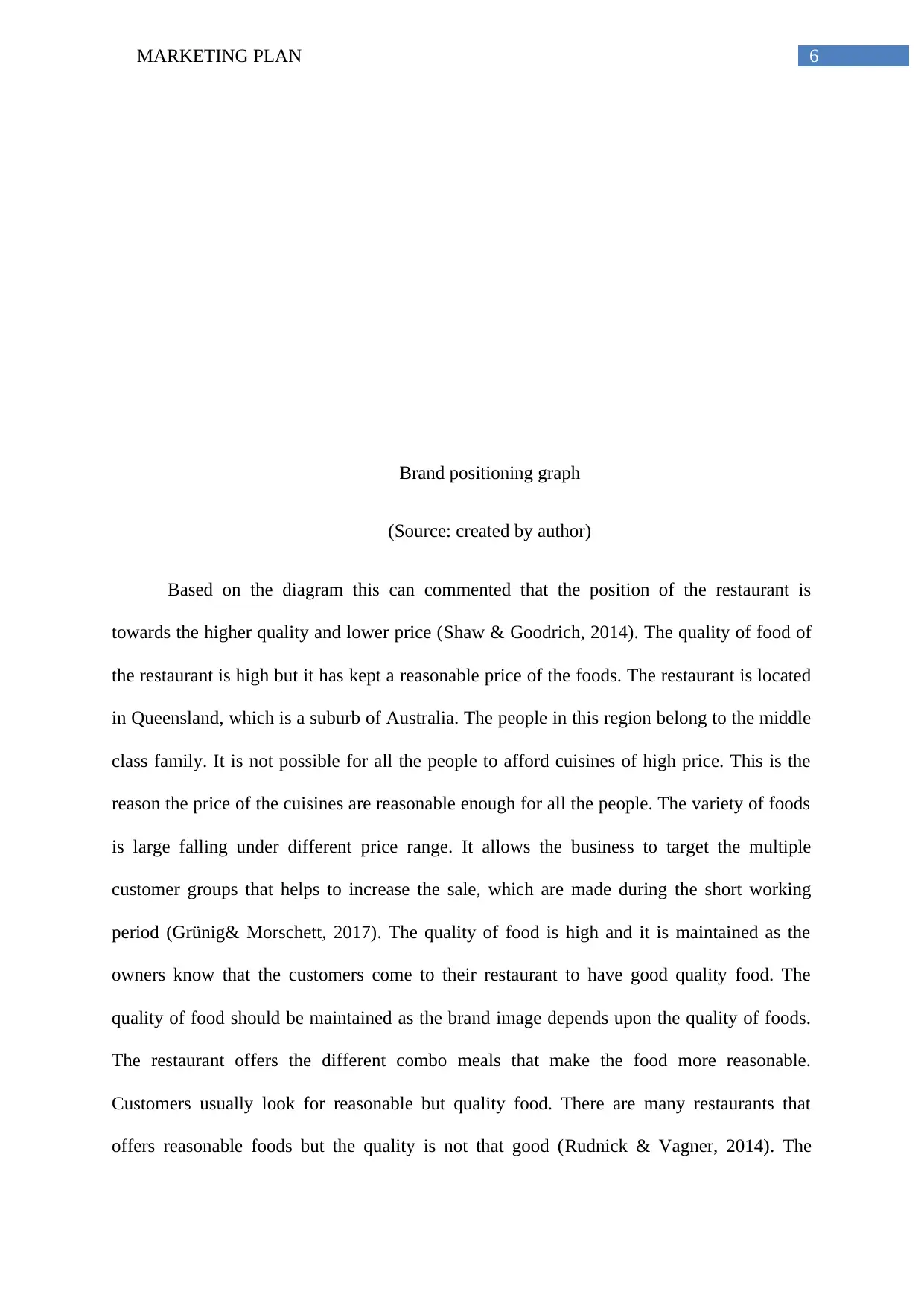
6MARKETING PLAN
Brand positioning graph
(Source: created by author)
Based on the diagram this can commented that the position of the restaurant is
towards the higher quality and lower price (Shaw & Goodrich, 2014). The quality of food of
the restaurant is high but it has kept a reasonable price of the foods. The restaurant is located
in Queensland, which is a suburb of Australia. The people in this region belong to the middle
class family. It is not possible for all the people to afford cuisines of high price. This is the
reason the price of the cuisines are reasonable enough for all the people. The variety of foods
is large falling under different price range. It allows the business to target the multiple
customer groups that helps to increase the sale, which are made during the short working
period (Grünig& Morschett, 2017). The quality of food is high and it is maintained as the
owners know that the customers come to their restaurant to have good quality food. The
quality of food should be maintained as the brand image depends upon the quality of foods.
The restaurant offers the different combo meals that make the food more reasonable.
Customers usually look for reasonable but quality food. There are many restaurants that
offers reasonable foods but the quality is not that good (Rudnick & Vagner, 2014). The
Brand positioning graph
(Source: created by author)
Based on the diagram this can commented that the position of the restaurant is
towards the higher quality and lower price (Shaw & Goodrich, 2014). The quality of food of
the restaurant is high but it has kept a reasonable price of the foods. The restaurant is located
in Queensland, which is a suburb of Australia. The people in this region belong to the middle
class family. It is not possible for all the people to afford cuisines of high price. This is the
reason the price of the cuisines are reasonable enough for all the people. The variety of foods
is large falling under different price range. It allows the business to target the multiple
customer groups that helps to increase the sale, which are made during the short working
period (Grünig& Morschett, 2017). The quality of food is high and it is maintained as the
owners know that the customers come to their restaurant to have good quality food. The
quality of food should be maintained as the brand image depends upon the quality of foods.
The restaurant offers the different combo meals that make the food more reasonable.
Customers usually look for reasonable but quality food. There are many restaurants that
offers reasonable foods but the quality is not that good (Rudnick & Vagner, 2014). The
Paraphrase This Document
Need a fresh take? Get an instant paraphrase of this document with our AI Paraphraser
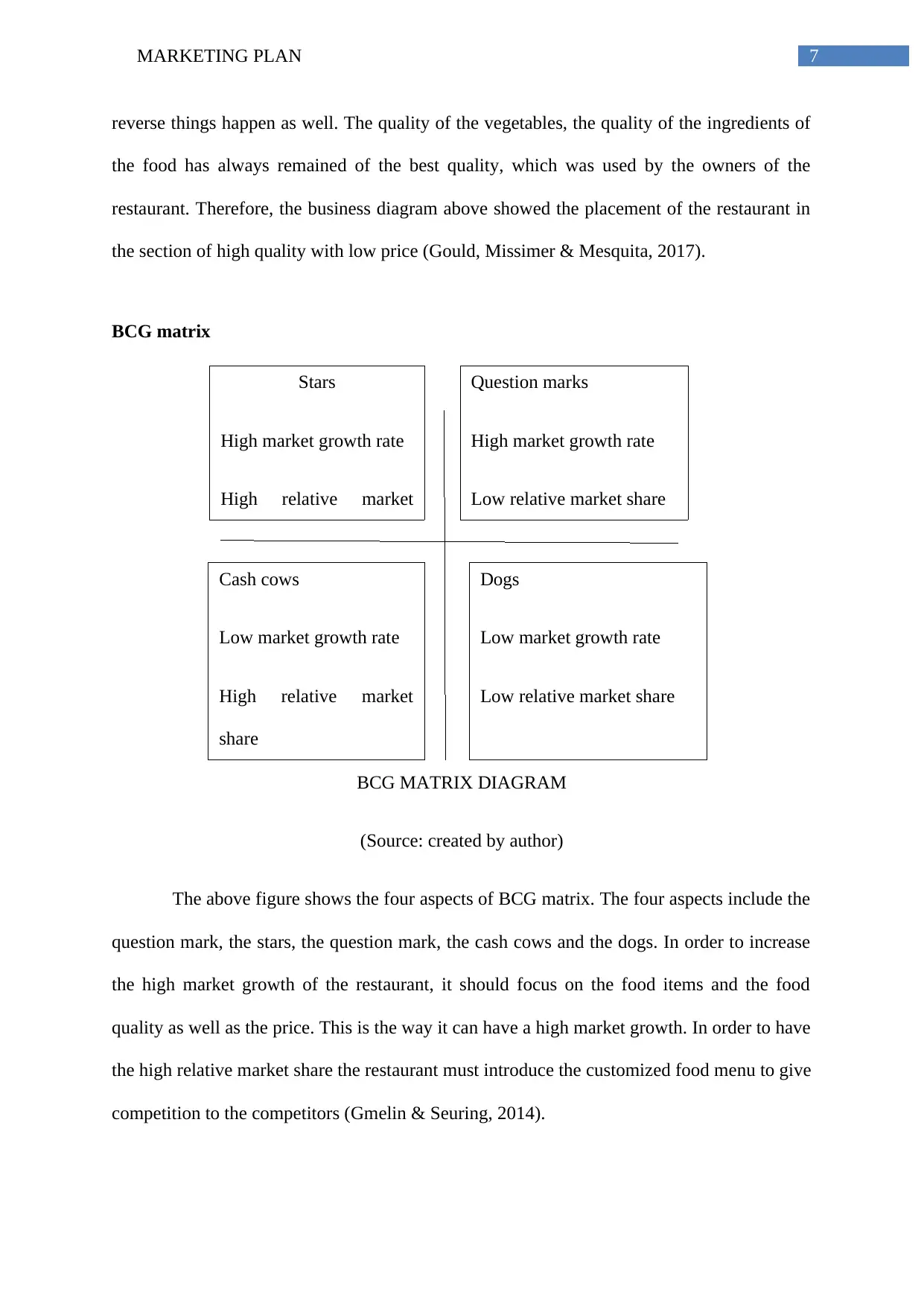
7MARKETING PLAN
reverse things happen as well. The quality of the vegetables, the quality of the ingredients of
the food has always remained of the best quality, which was used by the owners of the
restaurant. Therefore, the business diagram above showed the placement of the restaurant in
the section of high quality with low price (Gould, Missimer & Mesquita, 2017).
BCG matrix
BCG MATRIX DIAGRAM
(Source: created by author)
The above figure shows the four aspects of BCG matrix. The four aspects include the
question mark, the stars, the question mark, the cash cows and the dogs. In order to increase
the high market growth of the restaurant, it should focus on the food items and the food
quality as well as the price. This is the way it can have a high market growth. In order to have
the high relative market share the restaurant must introduce the customized food menu to give
competition to the competitors (Gmelin & Seuring, 2014).
Stars
High market growth rate
High relative market
share
Question marks
High market growth rate
Low relative market share
Cash cows
Low market growth rate
High relative market
share
Dogs
Low market growth rate
Low relative market share
reverse things happen as well. The quality of the vegetables, the quality of the ingredients of
the food has always remained of the best quality, which was used by the owners of the
restaurant. Therefore, the business diagram above showed the placement of the restaurant in
the section of high quality with low price (Gould, Missimer & Mesquita, 2017).
BCG matrix
BCG MATRIX DIAGRAM
(Source: created by author)
The above figure shows the four aspects of BCG matrix. The four aspects include the
question mark, the stars, the question mark, the cash cows and the dogs. In order to increase
the high market growth of the restaurant, it should focus on the food items and the food
quality as well as the price. This is the way it can have a high market growth. In order to have
the high relative market share the restaurant must introduce the customized food menu to give
competition to the competitors (Gmelin & Seuring, 2014).
Stars
High market growth rate
High relative market
share
Question marks
High market growth rate
Low relative market share
Cash cows
Low market growth rate
High relative market
share
Dogs
Low market growth rate
Low relative market share
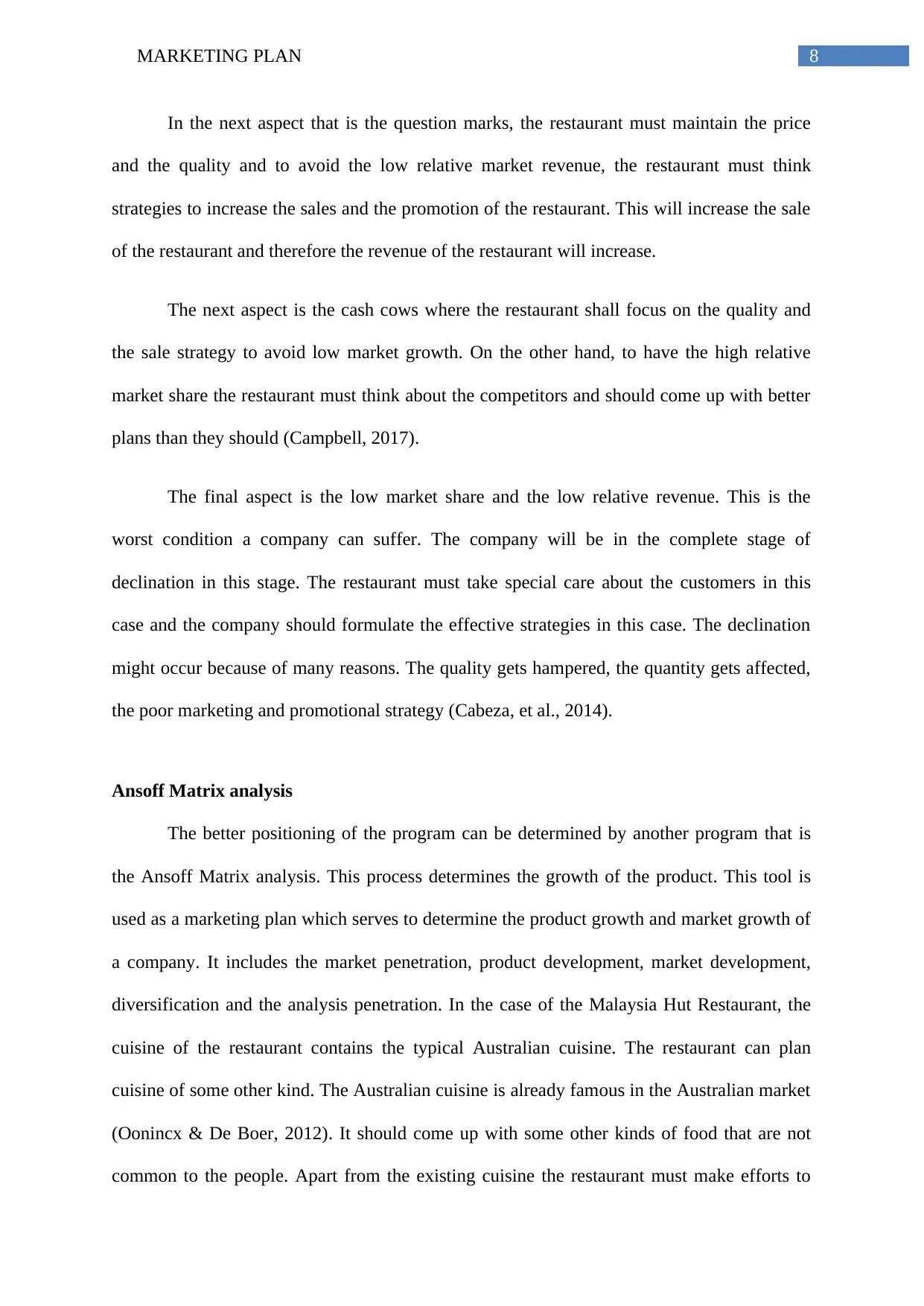
8MARKETING PLAN
In the next aspect that is the question marks, the restaurant must maintain the price
and the quality and to avoid the low relative market revenue, the restaurant must think
strategies to increase the sales and the promotion of the restaurant. This will increase the sale
of the restaurant and therefore the revenue of the restaurant will increase.
The next aspect is the cash cows where the restaurant shall focus on the quality and
the sale strategy to avoid low market growth. On the other hand, to have the high relative
market share the restaurant must think about the competitors and should come up with better
plans than they should (Campbell, 2017).
The final aspect is the low market share and the low relative revenue. This is the
worst condition a company can suffer. The company will be in the complete stage of
declination in this stage. The restaurant must take special care about the customers in this
case and the company should formulate the effective strategies in this case. The declination
might occur because of many reasons. The quality gets hampered, the quantity gets affected,
the poor marketing and promotional strategy (Cabeza, et al., 2014).
Ansoff Matrix analysis
The better positioning of the program can be determined by another program that is
the Ansoff Matrix analysis. This process determines the growth of the product. This tool is
used as a marketing plan which serves to determine the product growth and market growth of
a company. It includes the market penetration, product development, market development,
diversification and the analysis penetration. In the case of the Malaysia Hut Restaurant, the
cuisine of the restaurant contains the typical Australian cuisine. The restaurant can plan
cuisine of some other kind. The Australian cuisine is already famous in the Australian market
(Oonincx & De Boer, 2012). It should come up with some other kinds of food that are not
common to the people. Apart from the existing cuisine the restaurant must make efforts to
In the next aspect that is the question marks, the restaurant must maintain the price
and the quality and to avoid the low relative market revenue, the restaurant must think
strategies to increase the sales and the promotion of the restaurant. This will increase the sale
of the restaurant and therefore the revenue of the restaurant will increase.
The next aspect is the cash cows where the restaurant shall focus on the quality and
the sale strategy to avoid low market growth. On the other hand, to have the high relative
market share the restaurant must think about the competitors and should come up with better
plans than they should (Campbell, 2017).
The final aspect is the low market share and the low relative revenue. This is the
worst condition a company can suffer. The company will be in the complete stage of
declination in this stage. The restaurant must take special care about the customers in this
case and the company should formulate the effective strategies in this case. The declination
might occur because of many reasons. The quality gets hampered, the quantity gets affected,
the poor marketing and promotional strategy (Cabeza, et al., 2014).
Ansoff Matrix analysis
The better positioning of the program can be determined by another program that is
the Ansoff Matrix analysis. This process determines the growth of the product. This tool is
used as a marketing plan which serves to determine the product growth and market growth of
a company. It includes the market penetration, product development, market development,
diversification and the analysis penetration. In the case of the Malaysia Hut Restaurant, the
cuisine of the restaurant contains the typical Australian cuisine. The restaurant can plan
cuisine of some other kind. The Australian cuisine is already famous in the Australian market
(Oonincx & De Boer, 2012). It should come up with some other kinds of food that are not
common to the people. Apart from the existing cuisine the restaurant must make efforts to
⊘ This is a preview!⊘
Do you want full access?
Subscribe today to unlock all pages.

Trusted by 1+ million students worldwide
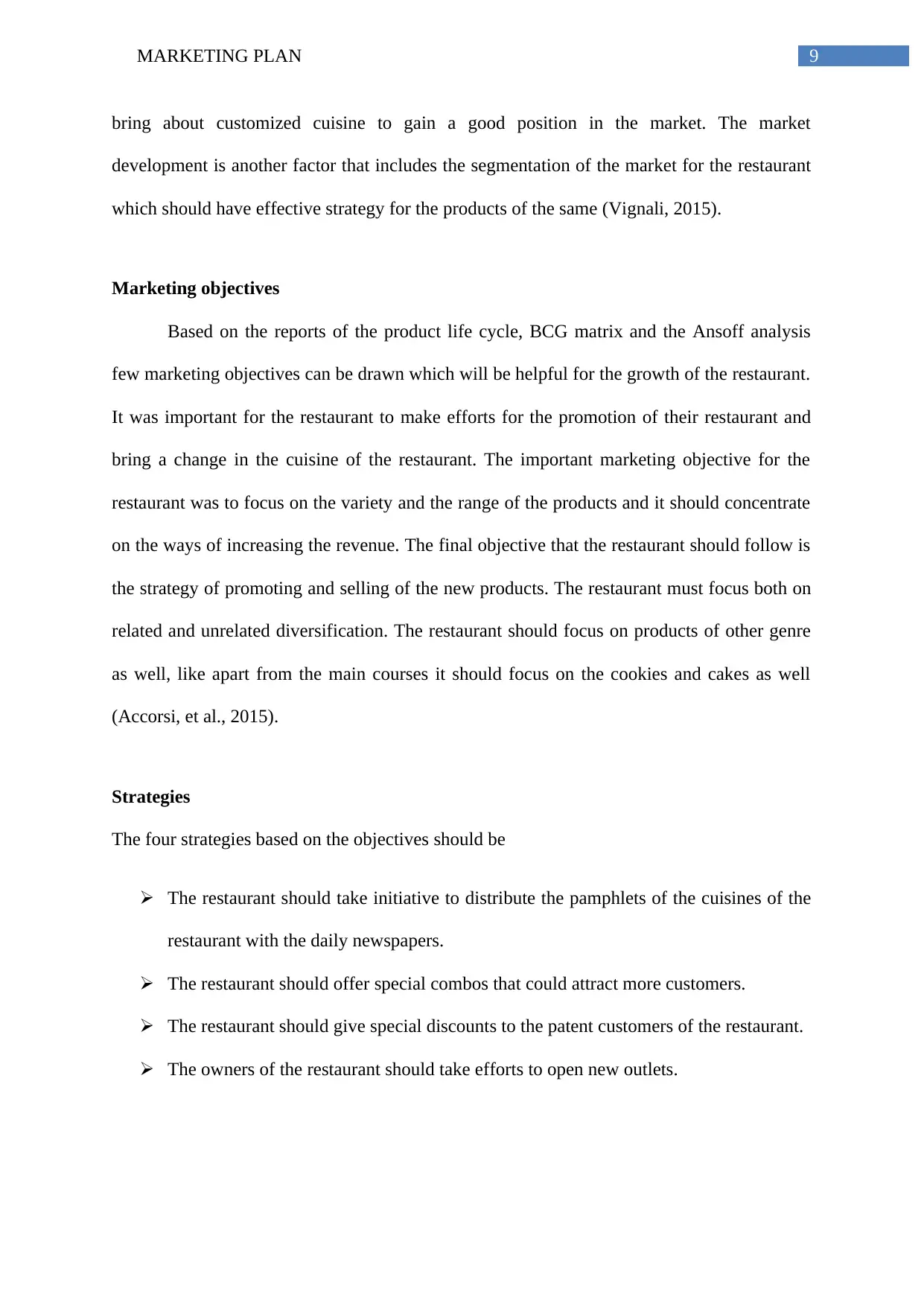
9MARKETING PLAN
bring about customized cuisine to gain a good position in the market. The market
development is another factor that includes the segmentation of the market for the restaurant
which should have effective strategy for the products of the same (Vignali, 2015).
Marketing objectives
Based on the reports of the product life cycle, BCG matrix and the Ansoff analysis
few marketing objectives can be drawn which will be helpful for the growth of the restaurant.
It was important for the restaurant to make efforts for the promotion of their restaurant and
bring a change in the cuisine of the restaurant. The important marketing objective for the
restaurant was to focus on the variety and the range of the products and it should concentrate
on the ways of increasing the revenue. The final objective that the restaurant should follow is
the strategy of promoting and selling of the new products. The restaurant must focus both on
related and unrelated diversification. The restaurant should focus on products of other genre
as well, like apart from the main courses it should focus on the cookies and cakes as well
(Accorsi, et al., 2015).
Strategies
The four strategies based on the objectives should be
The restaurant should take initiative to distribute the pamphlets of the cuisines of the
restaurant with the daily newspapers.
The restaurant should offer special combos that could attract more customers.
The restaurant should give special discounts to the patent customers of the restaurant.
The owners of the restaurant should take efforts to open new outlets.
bring about customized cuisine to gain a good position in the market. The market
development is another factor that includes the segmentation of the market for the restaurant
which should have effective strategy for the products of the same (Vignali, 2015).
Marketing objectives
Based on the reports of the product life cycle, BCG matrix and the Ansoff analysis
few marketing objectives can be drawn which will be helpful for the growth of the restaurant.
It was important for the restaurant to make efforts for the promotion of their restaurant and
bring a change in the cuisine of the restaurant. The important marketing objective for the
restaurant was to focus on the variety and the range of the products and it should concentrate
on the ways of increasing the revenue. The final objective that the restaurant should follow is
the strategy of promoting and selling of the new products. The restaurant must focus both on
related and unrelated diversification. The restaurant should focus on products of other genre
as well, like apart from the main courses it should focus on the cookies and cakes as well
(Accorsi, et al., 2015).
Strategies
The four strategies based on the objectives should be
The restaurant should take initiative to distribute the pamphlets of the cuisines of the
restaurant with the daily newspapers.
The restaurant should offer special combos that could attract more customers.
The restaurant should give special discounts to the patent customers of the restaurant.
The owners of the restaurant should take efforts to open new outlets.
Paraphrase This Document
Need a fresh take? Get an instant paraphrase of this document with our AI Paraphraser
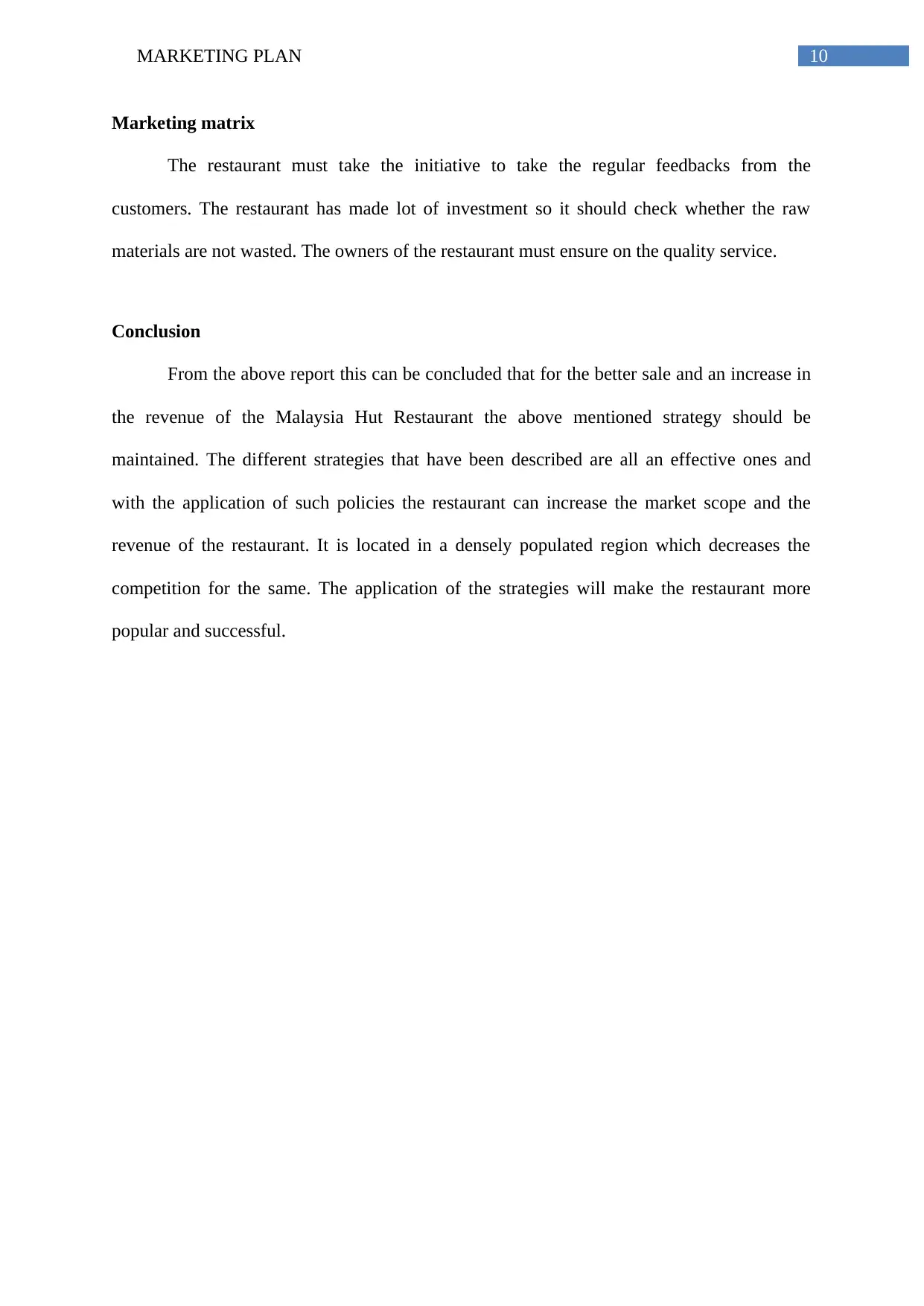
10MARKETING PLAN
Marketing matrix
The restaurant must take the initiative to take the regular feedbacks from the
customers. The restaurant has made lot of investment so it should check whether the raw
materials are not wasted. The owners of the restaurant must ensure on the quality service.
Conclusion
From the above report this can be concluded that for the better sale and an increase in
the revenue of the Malaysia Hut Restaurant the above mentioned strategy should be
maintained. The different strategies that have been described are all an effective ones and
with the application of such policies the restaurant can increase the market scope and the
revenue of the restaurant. It is located in a densely populated region which decreases the
competition for the same. The application of the strategies will make the restaurant more
popular and successful.
Marketing matrix
The restaurant must take the initiative to take the regular feedbacks from the
customers. The restaurant has made lot of investment so it should check whether the raw
materials are not wasted. The owners of the restaurant must ensure on the quality service.
Conclusion
From the above report this can be concluded that for the better sale and an increase in
the revenue of the Malaysia Hut Restaurant the above mentioned strategy should be
maintained. The different strategies that have been described are all an effective ones and
with the application of such policies the restaurant can increase the market scope and the
revenue of the restaurant. It is located in a densely populated region which decreases the
competition for the same. The application of the strategies will make the restaurant more
popular and successful.

11MARKETING PLAN
References
Accorsi, R., Manzini, R., Pini, C., & Penazzi, S. (2015). On the design of closed-loop
networks for product life cycle management: Economic, environmental and
geography considerations. Journal of Transport Geography, 48, 121-134.
Cabeza, L. F., Rincón, L., Vilariño, V., Pérez, G., & Castell, A. (2014). Life cycle assessment
(LCA) and life cycle energy analysis (LCEA) of buildings and the building sector: A
review. Renewable and Sustainable Energy Reviews, 29, 394-416.
Campbell, W. M. (2017). An Exploration of the Impact of the Use of Standard Management
Models on the Adoption of Green IT. GREEN 2017 Forward, 11.
Gmelin, H., & Seuring, S. (2014). Determinants of a sustainable new product
development. Journal of Cleaner production, 69, 1-9.
Gould, R., Missimer, M., & Mesquita, P. L. (2017). Using social sustainability principles to
analyse activities of the extraction lifecycle phase: learnings from designing support
for concept selection. Journal of Cleaner Production, 140, 267-276.
Grünig, R., & Morschett, D. (2017). General Strategic Planning as the Starting Point for
Going International for New Markets. In Developing International Strategies (pp. 57-
65). Springer Berlin Heidelberg.
Jenkins, W., & Williamson, D. (2015). Strategic management and business analysis.
Routledge.
Kim, J., Yun, C., Park, Y., & Park, C. H. (2015). Post-consumer energy consumption of
textile products during ‘use’phase of the lifecycle. Fibers and Polymers, 16(4), 926-
933.
References
Accorsi, R., Manzini, R., Pini, C., & Penazzi, S. (2015). On the design of closed-loop
networks for product life cycle management: Economic, environmental and
geography considerations. Journal of Transport Geography, 48, 121-134.
Cabeza, L. F., Rincón, L., Vilariño, V., Pérez, G., & Castell, A. (2014). Life cycle assessment
(LCA) and life cycle energy analysis (LCEA) of buildings and the building sector: A
review. Renewable and Sustainable Energy Reviews, 29, 394-416.
Campbell, W. M. (2017). An Exploration of the Impact of the Use of Standard Management
Models on the Adoption of Green IT. GREEN 2017 Forward, 11.
Gmelin, H., & Seuring, S. (2014). Determinants of a sustainable new product
development. Journal of Cleaner production, 69, 1-9.
Gould, R., Missimer, M., & Mesquita, P. L. (2017). Using social sustainability principles to
analyse activities of the extraction lifecycle phase: learnings from designing support
for concept selection. Journal of Cleaner Production, 140, 267-276.
Grünig, R., & Morschett, D. (2017). General Strategic Planning as the Starting Point for
Going International for New Markets. In Developing International Strategies (pp. 57-
65). Springer Berlin Heidelberg.
Jenkins, W., & Williamson, D. (2015). Strategic management and business analysis.
Routledge.
Kim, J., Yun, C., Park, Y., & Park, C. H. (2015). Post-consumer energy consumption of
textile products during ‘use’phase of the lifecycle. Fibers and Polymers, 16(4), 926-
933.
⊘ This is a preview!⊘
Do you want full access?
Subscribe today to unlock all pages.

Trusted by 1+ million students worldwide
1 out of 13
Related Documents
Your All-in-One AI-Powered Toolkit for Academic Success.
+13062052269
info@desklib.com
Available 24*7 on WhatsApp / Email
![[object Object]](/_next/static/media/star-bottom.7253800d.svg)
Unlock your academic potential
Copyright © 2020–2025 A2Z Services. All Rights Reserved. Developed and managed by ZUCOL.





